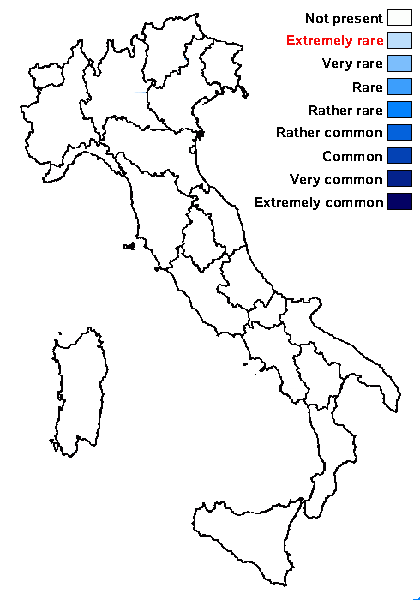Involucropyrenium llimonae (Etayo, Nav.-Ros. & Breuss) Breuss
Beitr. Naturk. Oberösterreichs, 13: 213, 2004. Basionym: Catapyrenium llimonae Etayo, Nav.-Ros. & Breuss - in Navarro-Rosinés & al., Candollea, 51, 1: 140, 1996
Synonyms:
Distribution:
Description: Thallus small-squamulose brown, matt, the squamules dispersed, (0.1-)0.3-0.5(-0.7) mm wide, (0.5-)0.7-1.5 mm thick, of irregular shape to digitate-coralloid. Upper cortex 10-20 µm thick, paraplectenchymatous, with a thin epinecral layer; algal layer occupying most of the thallus; medulla and lower cortex absent; rhizohyphae colourless, 3-5 µm thick. Perithecia black, originating amongst the squamules, globose to subconical, 0.2-0.4 mm wide. Exciple colourless to pale brown, 15-20 µm thick; involucrellum dark brown, completely surrounding the perithecium, 30-60 µm thick; hamathecium of periphyses, interascal filaments absent. Asci 8-spored, clavate, with biseriately arranged spores, the wall I-. Ascospores 1-celled, hyaline, broadly ellipsoid, (14-)16-21(-22) x (7-)9-11 µm. Photobiont chlorococcoid. Spot tests: cortex and medulla K-, C-, KC-, P- UV-. Chemistry: without lichen substances.Note: this characteristic species was described from Northern Spain (Navarra), growing on very eroded and weathered, gypsiferous and clayey soils, at 200-300 m; it should be looked for also in Italy.
Growth form: Squamulose
Substrata: soil, terricolous mosses, and plant debris
Photobiont: green algae other than Trentepohlia
Reproductive strategy: mainly sexual

Predictive model
Growth form: Squamulose
Substrata: soil, terricolous mosses, and plant debris
Photobiont: green algae other than Trentepohlia
Reproductive strategy: mainly sexual

Predictive model
 Index Fungorum
Index Fungorum
 GBIF
GBIF

